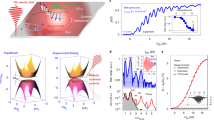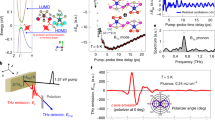Abstract
Symmetry plays a central role in conventional and topological phases of matter, making the ability to optically drive symmetry changes a critical step in developing future technologies that rely on such control. Topological materials, like topological semimetals, are particularly sensitive to a breaking or restoring of time-reversal and crystalline symmetries, which affect both bulk and surface electronic states. While previous studies have focused on controlling symmetry via coupling to the crystal lattice, we demonstrate here an all-electronic mechanism based on photocurrent generation. Using second harmonic generation spectroscopy as a sensitive probe of symmetry changes, we observe an ultrafast breaking of time-reversal and spatial symmetries following femtosecond optical excitation in the prototypical type-I Weyl semimetal TaAs. Our results show that optically driven photocurrents can be tailored to explicitly break electronic symmetry in a generic fashion, opening up the possibility of driving phase transitions between symmetry-protected states on ultrafast timescales.
This is a preview of subscription content, access via your institution
Access options
Access Nature and 54 other Nature Portfolio journals
Get Nature+, our best-value online-access subscription
$29.99 / 30 days
cancel any time
Subscribe to this journal
Receive 12 print issues and online access
$259.00 per year
only $21.58 per issue
Buy this article
- Purchase on Springer Link
- Instant access to full article PDF
Prices may be subject to local taxes which are calculated during checkout




Similar content being viewed by others
Data availability
Relevant material, data and associated protocols, including code and scripts, are curated and archived at the Materials Data Facility (https://doi.org/10.18126/lram-eh2d) and made available to the public.
References
Wen, X.-G. Topological orders and edge excitations in fractional quantum Hall states. Adv. Phys. 44, 405 (1995).
Sachdev, S. Topological order, emergent gauge fields, and Fermi surface reconstruction. Rep. Prog. Phys. 82, 014001 (2019).
Hasan, M. Z. & Kane, C. L. Colloquium: topological insulators. Rev. Mod. Phys. 82, 3045 (2010).
Ando, Y. & Fu, L. Topological crystalline insulators and topological superconductors: from concepts to materials. Annu. Rev. Condens. Matter Phys. 6, 361 (2015).
Gao, H., Venderbos, J. W., Kim, Y. & Rappe, A. M. Topological semimetals from first principles. Annu. Rev. Mater. Res. 49, 153 (2019).
Armitage, N. P., Mele, E. J. & Vishwanath, A. Weyl and Dirac semimetals in three-dimensional solids. Rev. Mod. Phys. 90, 015001 (2018).
Young, S. M. et al. Dirac semimetal in three dimensions. Phys. Rev. Lett. 108, 140405 (2012).
Wan, X., Turner, A. M., Vishwanath, A. & Savrasov, S. Y. Topological semimetal and Fermi-arc surface states in the electronic structure of pyrochlore iridates. Phys. Rev. B 83, 205101 (2011).
Xu, S.-Y. et al. Discovery of a Weyl fermion semimetal and topological Fermi arcs. Science 349, 613 (2015).
Yang, L. X. et al. Weyl semimetal phase in the non-centrosymmetric compound TaAs. Nat. Phys. 11, 728 (2015).
Liu, Z. K. et al. Evolution of the Fermi surface of Weyl semimetals in the transition metal pnictide family. Nat. Mater. 15, 27 (2015).
Jia, S., Xu, S.-Y. & Hasan, M. Z. Weyl semimetals, Fermi arcs and chiral anomalies. Nat. Mater. 15, 1140 (2016).
Parameswaran, S. A., Grover, T., Abanin, D. A., Pesin, D. A. & Vishwanath, A. Probing the chiral anomaly with nonlocal transport in three-dimensional topological semimetals. Phys. Rev. X 4, 031035 (2014).
Huang, X. et al. Observation of the chiral-anomaly-induced negative magnetoresistance in 3D Weyl semimetal TaAs. Phys. Rev. X 5, 031023 (2015).
Torchinsky, D. H. & Hsieh, D. in Magnetic Characterization Techniques for Nanomaterials (ed. Kumar, C. S.) 1–49 (Springer, 2017).
Zhao, L., Torchinsky, D., Harter, J., de la Torre, A. & Hsieh, D. in Encyclopedia of Modern Optics 2nd edn (eds Guenther, B. D. & Steel, D. G.) 207–226 (Elsevier, 2018).
Zhao, L. Evidence of an odd-parity hidden order in a spin–orbit coupled correlated iridate. Nat. Phys. 12, 32 (2016).
Harter, J. W., Zhao, Z. Y., Yan, J.-Q., Mandrus, D. G. & Hsieh, D. A parity-breaking electronic nematic phase transition in the spin-orbit coupled metal Cd2Re2O7. Science 356, 295 (2017).
Van Aken, B. B., Rivera, J.-P., Schmid, H. & Fiebig, M. Observation of ferrotoroidic domains. Nature 449, 702 (2007).
Jin, W. et al. Observation of a ferro-rotational order coupled with second-order nonlinear optical fields. Nat. Phys. 16, 42 (2020).
Ma, Q. et al. Direct optical detection of Weyl fermion chirality in a topological semimetal. Nat. Phys. 13, 842 (2017).
Sirica, N. et al. Tracking ultrafast photocurrents in the Weyl semimetal TaAs using THz emission spectroscopy. Phys. Rev. Lett. 122, 197401 (2019).
Gao, Y. et al. Chiral terahertz wave emission from the Weyl semimetal TaAs. Nat. Commun. 11, 720 (2020).
Wu, L. et al. Giant anisotropic nonlinear optical response in transition metal monopnictide Weyl semimetals. Nat. Phys. 13, 350 (2016).
Patankar, S. et al. Resonance-enhanced optical nonlinearity in the Weyl semimetal TaAs. Phys. Rev. B 98, 165113 (2018).
Osterhoudt, G. B. et al. Colossal photovoltaic effect driven by the singular Berry curvature in a Weyl semimetal. Nat. Mater. 18, 471 (2019).
Ma, J. et al. Nonlinear photoresponse of type-II Weyl semimetals. Nat. Mater. 18, 476 (2019).
Sipe, J. E. & Shkrebtii, A. I. Second-order optical response in semiconductors. Phys. Rev. B 61, 5337 (2000).
Li, Z. et al. Second harmonic generation in the Weyl semimetal TaAs from a quantum kinetic equation. Phys. Rev. B 97, 085201 (2018).
Morimoto, T. & Nagaosa, N. Topological nature of nonlinear optical effects in solids. Sci. Adv. 2, 1501524 (2016).
Sotome, M. et al. Spectral dynamics of shift current in ferroelectric semiconductor SbSI. Proc. Natl Acad. Sci. USA 116, 1929 (2019).
Parker, D. E., Morimoto, T., Orenstein, J. & Moore, J. E. Diagrammatic approach to nonlinear optical response with application to Weyl semimetals. Phys. Rev. B 99, 045121 (2019).
Weber, C. P. Ultrafast investigation and control of Dirac and Weyl semimetals. J. Appl. Phys. 129, 070901 (2021).
Khurgin, J. B. Current induced second harmonic generation in semiconductors. Appl. Phys. Lett. 67, 1113 (1995).
Ruzicka, B. A. et al. Second-harmonic generation induced by electric currents in GaAs. Phys. Rev. Lett. 108, 077403 (2012).
Zong, A. et al. Evidence for topological defects in a photoinduced phase transition. Nat. Phys. 15, 27 (2019).
Zong, A. et al. Dynamical slowing-down in an ultrafast photoinduced phase transition. Phys. Rev. Lett. 123, 097601 (2019).
Li, J. J., Chen, J., Reis, D. A., Fahy, S. & Merlin, R. Optical probing of ultrafast electronic decay in Bi and Sb with slow phonons. Phys. Rev. Lett. 110, 047401 (2013).
Murray, E. D. & Fahy, S. First-principles calculation of femtosecond symmetry-breaking atomic forces in photoexcited bismuth. Phys. Rev. Lett. 114, 055502 (2015).
O’Mahony, S. M. et al. Ultrafast relaxation of symmetry-breaking photo-induced atomic forces. Phys. Rev. Lett. 123, 087401 (2019).
Soifer, H. et al. Band-resolved imaging of photocurrent in a topological insulator. Phys. Rev. Lett. 122, 167401 (2019).
Takasan, K., Morimoto, T., Orenstein, J. & Moore, J. E. Current-induced second harmonic generation in inversion-symmetric Dirac and Weyl semimetals. Preprint at arXiv https://arxiv.org/abs/2007.08887 (2020).
Sheu, Y. M., Trugman, S. A., Yan, L., Jia, Q. X., Taylor, A. J. & Prasankumar, R. P. Using ultrashort optical pulses to couple ferroelectric and ferromagnetic order in an oxide heterostructure. Nat. Commun. 5, 5832 (2014).
Xu, B. et al. Optical spectroscopy of the Weyl semimetal TaAs. Phys. Rev. B 93, 121110 (2016).
Ozaki, T. Variationally optimized atomic orbitals for large-scale electronic structures. Phys. Rev. B 67, 155108 (2003).
Morrison, I., Bylander, D. M. & Kleinman, L. Nonlocal Hermitian norm-conserving Vanderbilt pseudopotential. Phys. Rev. B 47, 6728–6731 (1993).
Perdew, J. P., Burke, K. & Ernzerhof, M. Generalized gradient approximation made simple. Phys. Rev. Lett. 77, 3865–3868 (1996).
Theurich, G. & Hill, N. A. Self-consistent treatment of spin-orbit coupling in solids using relativistic fully separable ab initio pseudopotentials. Phys. Rev. B 64, 073106 (2001).
Lee, C.-C. et al. Fermi surface interconnectivity and topology in Weyl fermion semimetals TaAs, TaP, NbAs, and NbP. Phys. Rev. B 92, 235104 (2015).
Lee, C.-C., Lee, Y.-T., Fukuda, M. & Ozaki, T. Tight-binding calculations of optical matrix elements for conductivity using nonorthogonal atomic orbitals: anomalous Hall conductivity in bcc Fe. Phys. Rev. B 98, 115115 (2018).
Acknowledgements
This work was performed at the Center for Integrated Nanotechnologies at Los Alamos National Laboratory, a US Department of Energy, Office of Basic Energy Sciences user facility, under user proposal nos 2017BC0064 and 2019AU0167. Use of the Linac Coherent Light Source, SLAC National Accelerator Laboratory, is supported by the US Department of Energy, Office of Science, Office of Basic Energy Sciences under contract no. DE-AC02-76SF00515. N.S. and R.P.P. gratefully acknowledge the support of the US Department of Energy through the Los Alamos National Laboratory LDRD programme. P.P.O., J.-X.Z. and D.A.Y. are supported by the Center for Advancement of Topological Semimetals, an Energy Frontier Research Center funded by the US Department of Energy Office of Science, Office of Basic Energy Sciences, through the Ames Laboratory under contract no. DE-AC02-07CH11358. T.A.C. and M.Z.H. acknowledge support from the US Department of Energy under grant DE-FG-02-05ER46200. Work at University of California, Los Angeles was supported by the US Department of Energy, Office of Science, Office of Basic Energy Sciences under award no. DE-SC0021117 for single-crystal growth and characterization. C.H. thanks the support of the Julian Schwinger Fellowship at University of California, Los Angeles. M.S.S. acknowledges support from the National Science Foundation under grant no. DMR-1664842. C.-C.L. acknowledges the Ministry of Science and Technology of Taiwan for financial support under contract no. MOST 108-2112-M-032-010-MY2. T.A.C. was supported by the National Science Foundation Graduate Research Fellowship Program under grant no. DGE-1656466. M.T. and S.W.T. were supported by the US Department of Energy, Office of Science, Office of Basic Energy Sciences through the Division of Materials Sciences and Engineering under contract no. DE-AC02-76SF00515. We thank Y.-M. Sheu for the helpful discussion.
Author information
Authors and Affiliations
Contributions
TaAs single crystals were grown and characterized by L.X.Z., G.F.C., B.X., R.Y., B.S., C.H., N.N. and X.G.Q., with additional sample characterization and physical insights provided by T.A.C. and M.Z.H.; N.S. and Y.M.D. performed the TR-SHG experiments with help from M.-C.L., P.P. and L.T.M.; N.S., S.W.T., M.T. and R.P.P. performed the time-resolved X-ray diffraction experiments with help from Linac Coherent Light Source staff. The data were analysed by N.S., P.P.O. and M.S.S. with a detailed symmetry analysis performed by P.P.O. and M.S.S. Ab initio calculations were carried out by C.-C.L. and H.L. with additional insight provided by J.-X.Z. The manuscript was written by N.S., P.P.O., M.S.S. and R.P.P. with added contributions from S.A.T., A.J.T. and D.A.Y.
Corresponding authors
Ethics declarations
Competing interests
The authors declare no competing interests.
Additional information
Peer review information Nature Materials thanks Liuyan Zhao and the other, anonymous, reviewer(s) for their contribution to the peer review of this work.
Publisher’s note Springer Nature remains neutral with regard to jurisdictional claims in published maps and institutional affiliations.
Supplementary information
Supplementary Information
Supplementary Figs. 1–11, Tables 1–4 and Discussion Sections I–XII.
Rights and permissions
About this article
Cite this article
Sirica, N., Orth, P.P., Scheurer, M.S. et al. Photocurrent-driven transient symmetry breaking in the Weyl semimetal TaAs. Nat. Mater. 21, 62–66 (2022). https://doi.org/10.1038/s41563-021-01126-9
Received:
Accepted:
Published:
Issue Date:
DOI: https://doi.org/10.1038/s41563-021-01126-9
This article is cited by
-
Electric quadrupole second-harmonic generation revealing dual magnetic orders in a magnetic Weyl semimetal
Nature Photonics (2024)
-
Light-driven nanoscale vectorial currents
Nature (2024)
-
Light-induced electronic polarization in antiferromagnetic Cr2O3
Nature Materials (2024)
-
Terahertz control of many-body dynamics in quantum materials
Nature Reviews Materials (2023)
-
Ultrafast terahertz emission from emerging symmetry-broken materials
Light: Science & Applications (2023)



